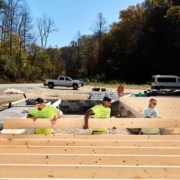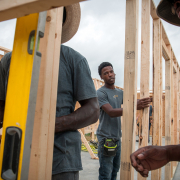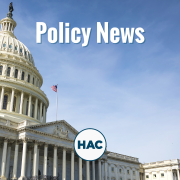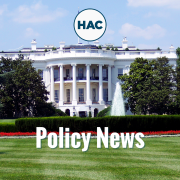HAC News Formats. pdf
May 13, 2021
Vol. 50, No. 10
TOP STORIES
Eviction moratorium remains in effect while under court review.
Ruling that the Centers for Disease Control did not have the legal authority to issue its moratorium on evictions, a federal judge on May 6 declared the measure invalid, then temporarily stayed her order when the Justice Department appealed it. Numerous other suits have been filed in state and federal courts, with some judges upholding the moratorium and others finding it did not apply in specific cases.
New guidance will help tenants access Emergency Rental Assistance.
On May 7, when the Treasury Department allocated $21.6 billion to states and localities in Emergency Rental Assistance funds appropriated by the American Rescue Plan Act, it also revised its FAQs and fact sheet for the program. The new documents address some of the challenges faced by tenants trying to use the first round of ERA aid. For example, they require program administrators to provide relief directly to tenants whose landlords decline to participate, and to help tenants in federally assisted housing pay their share of rents. Summaries comparing the ERA 1 and ERA 2 programs are available from the National Low Income Housing Coalition and National Council of State Housing Agencies.
USDA homeowner refi funds available soon, officials tell Congress.
The Biden administration’s plans for USDA Rural Development were examined in a May 6 House Agriculture Appropriations Subcommittee virtual hearing. Funds from the American Rescue Plan Act will be used to refinance loans to USDA single-family borrowers who have been under forbearance during the pandemic, said Chad Parker, Acting RHS Administrator. USDA expects to issue guidance to its staff later in May and then to begin accepting applications for these refinances in late May or early June. The $39 million appropriation will yield about $650 million in Section 502 direct mortgages and $18.8 million in Section 504 home repair loans. The American Rescue Plan Act also provided $100 million for new Section 521 Rental Assistance; USDA has already issued guidance for field staff regarding these funds. The hearing also touched on the backlogged MPR rental preservation program, subsidy recapture for Section 502 homeowners, the need for local capacity building and USDA staff levels; a summary is posted on HAC’s website.
May is Asian American and Native Hawaiian/Pacific Islander Heritage Month.
President Biden’s proclamation includes condemnation of anti-Asian bias and violence.
RuralSTAT
Over the past year an average of 4.6% of U.S. homeowners and 12.4% of renters lacked confidence in their ability to make their next mortgage or rent payment. Source: HAC tabulations of the U.S. Census Bureau’s Pulse Survey.
OPPORTUNITIES
HUD offers Choice Neighborhood Planning Grants.
Nonprofits, PHAs, local governments and tribal entities can apply by July 13 for grants to develop comprehensive neighborhood revitalization strategies to guide the revitalization of public or assisted housing and transformation of surrounding neighborhoods.
Emergency Broadband Benefit program launched.
The Federal Communications Commission is offering discounts to low-income people for broadband service and computer purchases during the coronavirus pandemic. The program can be used for a new or existing broadband plan from a participating provider. It will end when funds are exhausted or six months after the federal government declares an end to the pandemic. FCC also offers outreach materials, including handouts in several languages. For more information contact a broadband provider, visit FCC’s webpage or call 833-511-0311 to receive an application by mail.
NEW Conference Coordinator job opening at HAC; Community Facilities Housing Specialist also open.
For details, visit HAC’s website.
- The Conference Coordinator supports every part of preparing and delivering HAC’s 2021 National Rural Housing Conference. Excellent communication skills and attention to detail are vital, along with proven experience in conference and/or event planning to include logistic coordination. This is a full-time, temporary position and is eligible for telecommuting.
- The Community Facilities Housing Specialist identifies and engages community stakeholders and provides direct technical assistance to rural organizations that are developing facilities such as parks, community centers, public libraries and childcare centers. This includes helping them identify, utilize and apply for financial resources such as USDA Community Facilities grants and loans. This a two-year position and is eligible for telecommuting.
CORONAVIRUS
Administration’s vaccination goal includes rural outreach.
The federal effort to vaccinate 70% of American adults by July 4 involves supports directed at underserved communities, including rural places. The White House aims to improve rural access by sending vaccines directly to rural health clinics, funding rural clinics to conduct education and outreach, and helping rural clinics and hospitals broaden their testing and mitigation work.
HUD and HHS work together to increase testing and vaccinations.
HUD Secretary Marcia Fudge and Health and Human Services Secretary Xavier Becerra announced a joint-agency effort to increase access to COVID-19 prevention and treatment services, including testing and vaccinations, among disproportionately affected communities, including among HUD-assisted households and people experiencing homelessness. They asked community health centers, HUD grantees and others to assist with registering and scheduling tests and vaccination appointments and facilitating on-site vaccine clinics.
“Why lagging COVID vaccine rate at rural hospitals ‘needs to be fixed now.’”
This story by National Public Radio reports on relatively low rates of vaccinations among rural health care workers. The National Rural Health Association and Chartis Center for Rural Health surveyed rural hospital executives, 30% of whom said less than half their employees had been vaccinated. About the same proportion said that 70% or more of their staff were vaccinated.
Guide proposes ways for local coronavirus funding to advance racial equity.
10 Priorities for Advancing Racial Equity Through the American Rescue Plan: A Guide for City and County Policymakers, published by PolicyLink, is addressed to city and county governments receiving recovery funds from the Treasury Department. The guide provides a worksheet with questions to help achieve the ten priorities, which include explicitly naming racial equity as a goal, engaging historically underserved communities in prioritizing investments, and preventing displacement and increasing community ownership of land and housing.
REGULATIONS AND FEDERAL AGENCIES
Comments sought on government reaching underserved communities, including rural.
Rural residents are among several examples of underserved populations identified in an Office of Management and Budget notice requesting input by July 6 on methods, approaches and tools that could help determine whether federal agency policies and actions equitably serve all eligible individuals and communities. For more information, contact Amira Boland, OMB, 202-395-5222.
USDA updates guidance for Community Facilities programs.
USDA Rural Development released three documents on May 11 with information relevant to applicants or recipients of CF direct loans, loan guarantees or grants: best practices for RD staff to evaluate proposed projects; documentation required when a direct loan applicant has less than five years of successful operations; and requirements for submitting audit reports or financial statements.
Vilsack confirms ERS and NIFA will stay in Kansas City.
USDA will not move the Economic Research Service and National Institute of Food and Agriculture back to Washington, DC, Agriculture Secretary Tom Vilsack has stated. The Counter reports representatives of the employees’ union agreed that was the least disruptive decision and recommended hiring remote workers to rebuild staff capacity. The Trump administration relocated the agencies in 2019.
PUBLICATIONS AND MEDIA
Mortgage interest deduction increases racial disparities, research shows.
The income tax deduction available to higher-income homeowners contributes to economic and racial inequality, the National Low Income Housing Coalition and the Institute for Economic and Racial Equity at Brandeis University write in a new report. Misdirected Housing Supports: Why the Mortgage Interest Deduction Unjustly Subsidizes High-Income Households and Expands Racial Disparities explains that affluent white households benefit disproportionately from the deduction. The authors propose ending the MID and directing those federal resources to help rectify unjust racial disparities.
Rural places received few early Opportunity Zones investments.
A University of California Berkeley analysis, Neighborhood-Level Investment from the U.S. Opportunity Zone Program: Early Evidence, finds that in 2019, Opportunity Zone capital was highly concentrated in only 16% of the eligible census tracts nationwide and focused on places with relatively high incomes, pre-existing upward trends in incomes and home values, and declining shares of elderly and non-white residents. These OZ investments focused on real estate, both commercial and residential. The paper emphasizes that the available data was incomplete and covered only the program’s early implementation; a review by the Economic Innovation Group reinforces this point. The Berkeley researchers established baselines against which to measure impacts of OZ investments as more data becomes available in the future.
New analysis illustrates U.S. broadband gaps.
Using publicly available Microsoft data, the Verge created an interactive map showing the proportion of people in each county who use the internet at broadband speed. The data does not indicate whether broadband is unavailable in a given area or is available but unaffordable for residents.
“In rural towns like Kit Carson, a housing and development conundrum born of rising costs, disrepair – and lots of asbestos.”
The Colorado Sun article uses one town’s example to highlight threats facing many others, including “declining population, shifting economics of agriculture, absentee property ownership, and an aging and too-often-deteriorating housing inventory.” Many rural towns struggle to balance investing in rehabilitation of current housing stock and economic development. Their goal is to have enough jobs and housing for the next generation to stay.
CITIZENS’ INSTITUTE FOR RURAL DESIGN
American Artscape features Mt. Zion Baptist Church.
A 2019 recipient of funding from the Citizens’ Institute on Rural Design, the Mt. Zion Baptist Church Preservation Society is receiving national recognition for its leadership in elevating black voices and history. The church is featured in the latest issue of American Artscape, a magazine of the National Endowment for the Arts, which focuses on equity and access for the arts in black communities. CIRD design team lead and HAC collaborator Omar Hakeem is interviewed in this story about partnership with architects to redesign a historically black church in Appalachian Ohio and what that inspires in the community.
National Endowment for the Arts announces $88 million in 2021 funding awards.
NEA award recipients include two communities that participated in the Citizens’ Institute on Rural Design in 2019 and have now received additional funding through the Our Town program: the Pike School of Art in McComb, MS and Snow Pond Center for the Arts (New England Music Camp) in Sidney, ME.
HAC
Need capital for your affordable housing project?
HAC’s loan fund provides low interest rate loans to support single- and multifamily affordable housing projects for low-income rural residents throughout the U.S. and territories. Capital is available for all types of affordable and mixed-income housing projects, including preservation, new development, farmworker, senior and veteran housing. HAC loan funds can be used for pre-development, site acquisition, site development, construction/rehabilitation and permanent financing. Contact HAC’s loan fund staff at hacloanfund@ruralhome.org, 202-842-8600.
Please note: HAC is not able to offer loans to individuals or families. Borrowers must be nonprofit or for-profit organizations or government entities (including tribes).







